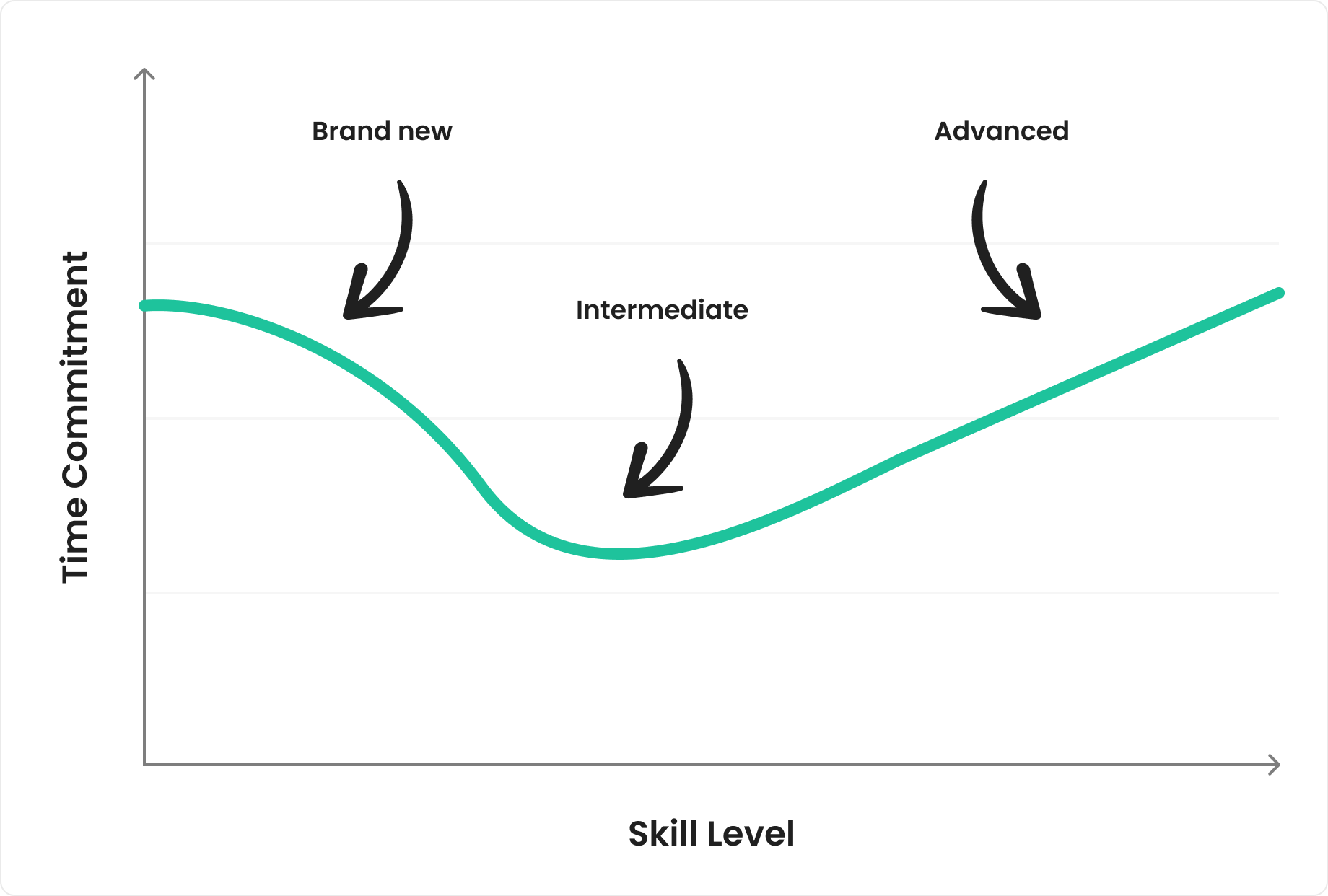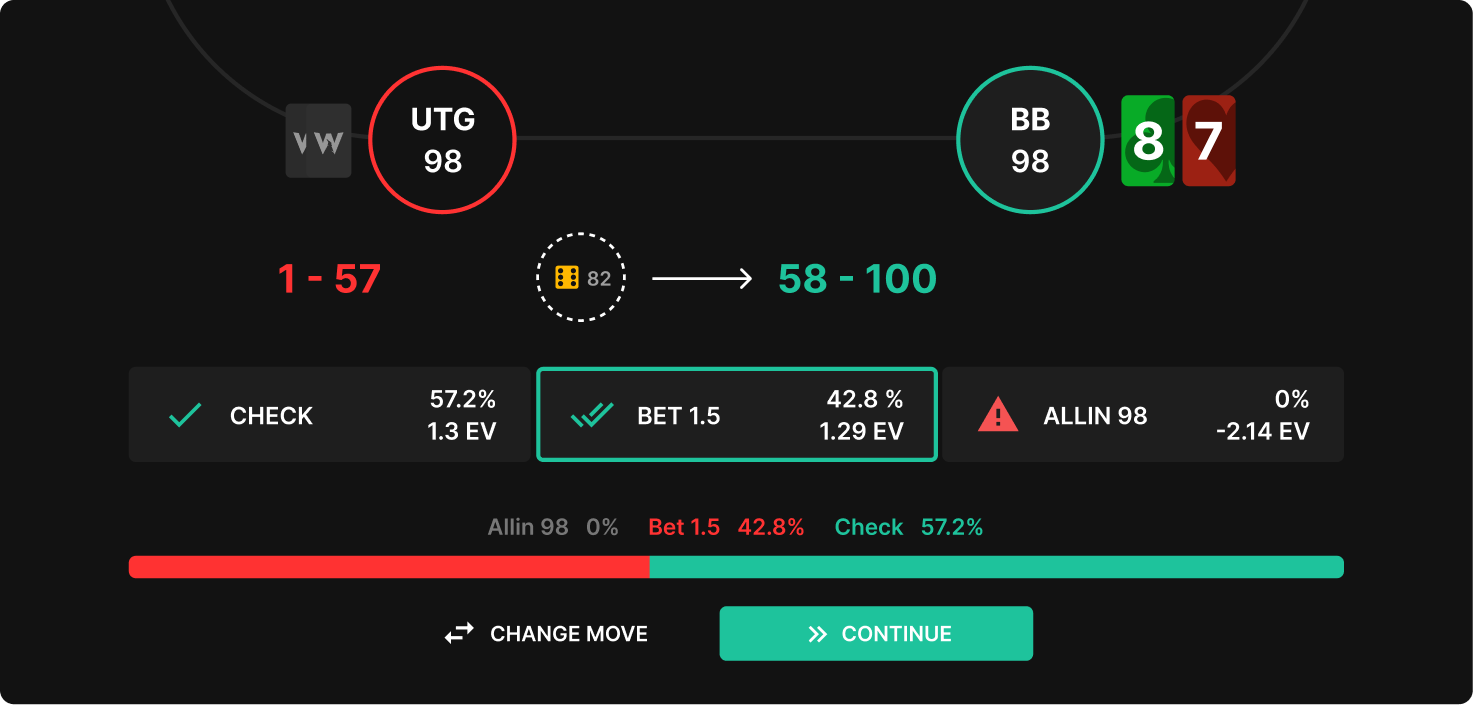The 5 Levels of Trainer Mastery for Cash Games
Learning poker is daunting; the process can feel like hitting your head against a wall for those starting out. Fortunately, if you’re adamant about taking on the challenge, you’ve come to the right place. Let GTO Wizard be your helmet; with time—and training—the wall in front of you will begin to crumble.
Before jumping headfirst into the trainer, let’s consider the best way to improve quickly.
The Principles of Fast and Effective Learning
1) Training Difficulty Should Suit Current Abilities
We learn fastest when challenged but not overwhelmed. Think of a powerlifter. Powerlifters build themselves up to incredibly hefty weights, but imagine if they had tried to lift those weights on day one—they wouldn’t have been able to do it!
Powerlifters would also not gain strength if they kept to weights they could comfortably lift. Poker is the same; we should challenge ourselves, but stepping back is okay if we’re perplexed—just not too far!
2) Focus on One Spot at a Time, but Aim To Cover All Spots
Poker is a complex game with many spots to master, but we have to start somewhere. The best start zeroes in on the most important one but aims to branch out quickly from there.
It helps to study one spot at a time to recognize patterns, but this can lead to leaning on them when inappropriate! Studying a spot too intensely carries the risk of overgeneralizing—just because a particular strategy appears in one spot does not mean it will always occur in others.
Pick a few spots each day, and study them for no more than 20 minutes at a time each.
The more you stretch your brain, the faster you learn. If it’s slightly uncomfortable, you’re doing it right!
3) Create a Routine
Consistency is vital to any study routine, and the best way to achieve consistency is to create a solid plan.
The first step in creating any plan should be determining what purpose you are trying to accomplish and how seriously you want to take the game. With a purpose in mind, you will now be way more effective in devising a plan to enact the required commitment. This is different for everyone, but generally, how much you get out depends on how much you have put in.
When the goal is to learn a new skill deeply, full immersion (e.g., a language bath) is hard to beat. So it’s best to invest a few hours each day.
As you gain fluency in poker, it’s okay to scale back the study time commitment to allow for more time to play poker, to practice what you studied.
Once you reach an advanced level, it will once again become necessary to invest a larger amount of time to see consistent improvement.
Another very important element of creating a good study plan is accounting for recovery. The brain is a muscle like any other, and once tired, the amount of new information it can process will drastically reduce.
I personally enjoy bookending my poker sessions by studying before and after each session. But even just breaking up a long study session with time for a meal is enough for a much-needed mental reset.
4) Set Goals and Track Progress
Setting goals and monitoring progress are often overlooked when creating a study plan. It’s easy to lose motivation when progress feels stagnant, and this feeling has free rein if you don’t have a meaningful way to look back and measure how far you’ve come.
Goals can be very flexible, ranging from something as specific as “get x score on y drill” to something as simple as “stick to my study plan for a week.”
Lastly, all roads lead to Rome (or the Mirage) when it comes to poker learning! Don’t let the fear of not studying in the best possible way prevent you from studying at all because that is the only way you are guaranteed to not improve.
The Five Levels of Trainer Mastery
Level 1: The Apprentice
Everyone starts somewhere, and a solid foundation goes a long way in the poker universe.
Learning optimal preflop opening and defending ranges will put you ahead of a decent chunk of your low-stakes competition. The drills at this level aim to lay the most robust possible foundation you can build upon confidently.
All drills use High RNG, which can be a learning curve for newer players. However, learning to use RNG while training as early as possible will help you avoid many future setbacks and pitfalls.
Level 1 Drills:
Level 1 Drills:
Part of playing good poker is staying unpredictable by not playing our hands the same way each time. As humans, we intuitively understand this, but believe it or not, robots do too!
A common way for (online) poker players to remain unpredictable is to roll a number using a Random Number Generator (RNG).
The higher you roll, the more aggressive your action. For example, if you believe a hand should bluff 10% of the time and fold the rest, you would bluff on a roll of 91–100 and fold rolls of 1–90.
The GTO Wizard trainer comes with an optional inbuilt RNG that functions in much the same way.
In this second example, we rolled an 82 (displayed next to the dice icon). In High RNG mode, that means betting 1.5bb is considered the most correct action despite being a minority play.
But shouldn’t we always aim to play in a way that maximally exploits our opponent?
Absolutely! Randomization should only be used to keep frequencies under control and when up against very advanced opponents (who are able to counter-exploit us). In situations where that’s not the case, an exploitative read will be the superior guide for our actions relative to randomization.
Training with an RNG forces us to play and understand all lines, allowing us to be prepared for whatever the game throws our way. If we only study the majority lines, we’ll develop huge blind spots, reducing our ability to craft exploits.
To learn more about working with the trainer in RNG mode, see this guide.
Level 2: The Novice
Now that we’ve learned the basics, it’s time to start working on a few slightly trickier preflop spots and introduce postflop study into the routine!
Learning postflop can be quite a leap from preflop because there are exponentially more scenarios. For this reason, we will limit ourselves to the flop for now, but brace yourself! Things ramp up quite quickly from here.
Recommended resource:
Level 2 Drills:
2
2
2
2
2
2.5
2.5
2.5
2.5
2.5
🟨
🟨
🟨
🟨
🟨
🟨
🟨
🟨
🟨
🟨
Level 2 Drills:
2 🟨 BB Defense vs SB Open (Preflop)
2 🟨 SB vs CO/BTN Open (Preflop)
2 🟨 BTN vs Open (All Sizes)
2 🟨 BB vs BTN SRP (Flop Only)
2 🟨 BB vs UTG SRP (Flop Only)
2.5 🟨 HJ/CO) vs (UTG/HJ) Open (All Sizes)
2.5 🟨 BB vs IP PFR (Flop Only)
2.5 🟨 BTN vs SB/BB 3-Bet (Preflop)
2.5 🟨 UTG vs SB/BB 3-Bet (Preflop)
2.5 🟨 CO vs BTN 3-Bet (Preflop)
Level 3: The Scholar
This is the toughest level so far and covers a myriad of spots. The good news is that if you manage to complete it, you’ll have made so much progress that you’re relatively close to being prepared for whatever the game has to throw at you.
Level 3 Drills:
3
3
3
3
3
3
3
3.5
3.5
3.5
3.5
🟧
🟧
🟧
🟧
🟧
🟧
🟧
🟧
🟧
🟧
🟧
Level 3 Drills:
3 🟧 OOP vs BTN 3-Bet (Preflop)
3 🟧 BB vs IP (Flop Only)
3 🟧 BTN vs BB SRP (Full Hand)
3 🟧 BB vs UTG SRP (Full Hand)
3 🟧 SB vs BB 3-Bet (Preflop)
3 🟧 CO vs BTN 3-Bet Pot (Flop Only)
3 🟧 SB vs BTN 3-Bet Pot (Flop Only)
3.5 🟧 BB vs IP (Full Hand)
3.5 🟧 SB vs BB SRP (Flop Only)
3.5 🟧 UTG vs SB 3-Bet Pot (Flop Only)
3.5 🟧 IP vs SB/BB 3-Bet (Preflop)
Level 4: The Mage
I commend you for having come this far. You have reached the point where the common spots in poker are unlikely to throw you off. Let’s move into more exotic terrain by tackling typically less studied spots. If you can learn to play proficiently at this level, you’ll have an edge on almost all online low-stakes and live competition.
One of the things that you’ll likely notice while advancing through this level is that the strategies in single-raised pots, 3-bet pots, and 4-bet pots can play pretty differently from each other. Thankfully, GTO Wizard offers a wealth of resources that can be used to deepen your understanding. As always, if you stick with it, your comprehension and confidence will grow.
Recommended resources:
Level 4 Drills:
4
4
4
4
4
4
4.5
4.5
4.5
4.5
4.5
4.5
4.5
🟥
🟥
🟥
🟥
🟥
🟥
🟥
🟥
🟥
🟥
🟥
🟥
🟥
BTN vs UTG/HJ/CO 4-Bet (Preflop)
Blinds vs IP 4-Bet (Preflop)
SB vs BB SRP (Full Hand)
HJ/CO vs SB (Flop Only)
UTG vs SB 3-Bet Pot (Full Hand)
BTN vs SB 3-Bet Pot (Full Hand)
Preflop Squeeze Training
UTG/HJ/CO vs BTN Cold Call (Full Hand)
IP vs SB Cold Call (Full Hand)
IP vs SB 3-Bet Pot (Full Hand)
SB vs BB 3-Bet Pot (Full Hand)
SB vs BB 4-Bet Pot (Full Hand)
BTN vs UTG/HJ/CO 4-Bet (Full Hand)
Level 4 Drills:
4 🟥 BTN vs UTG/HJ/CO 4-Bet (Preflop)
4 🟥 Blinds vs IP 4-Bet (Preflop)
4 🟥 SB vs BB SRP (Full Hand)
4 🟥 HJ/CO vs SB (Flop Only)
4 🟥 UTG vs SB 3-Bet Pot (Full Hand)
4 🟥 BTN vs SB 3-Bet Pot (Full Hand)
4.5 🟥 Preflop Squeeze Training
4.5 🟥 UTG/HJ/CO vs BTN Cold Call (Full Hand)
4.5 🟥 IP vs SB Cold Call (Full Hand)
4.5 🟥 IP vs SB 3-Bet Pot (Full Hand)
4.5 🟥 SB vs BB 3-Bet Pot (Full Hand)
4.5 🟥 SB vs BB 4-Bet Pot (Full Hand)
4.5 🟥 BTN vs UTG/HJ/CO 4-Bet (Full Hand)
Level 5: The Wizard
This level is designed to simulate actual play by throwing every possible spot at you. Summon the pattern recognition ability you’ve cultivated and fuse it with both strategic thinking and instinctual feeling. If you can synthesize all of these elements in the right ratios, you will have acquired the skill set to produce GTO’s unexploitable strategies, something that others view as arcane magic, but you know how to conjure when the time calls for it.
Level 5 Drills:
Level 5 Drills:
Level ∞: The GTO Wizard (Has No Limit to Learning)
Whether you’ve completed all the levels or only stayed for the study tips, learning is a continuous process. If you make a resolution to apply yourself daily and actually follow through on it, then improvement is inevitable! This not only goes for poker but extends to anything one can pursue in life.
Now is a great time to check the stats page to see what drills you did best on and what could use improvement. Use this performance guide if you’re new to this aspect of the app.
How you choose to continue your poker journey from here is entirely up to you! Remember to challenge yourself and practice a wide variety of spots. With each study session, you’re chipping away at the wall that is understanding poker. Hopefully, by now, the wall no longer looks so impenetrable.
The BB’s incentives for calling an SB preflop raise differ from those of a cold-caller facing a raise from, say, LJ or CO. And the SB’s incentives for raising differ from those of an open-raiser in any other position.
Author
Madmanslime
Steven Zahr is an up-and-coming mid-stakes cash game player with a knack for understanding and dissecting GTO solutions.
Wizards, you don’t want to miss out on ‘Daily Dose of GTO,’ it’s the most valuable freeroll of the year!
We Are Hiring
We are looking for remarkable individuals to join us in our quest to build the next-generation poker training ecosystem. If you are passionate, dedicated, and driven to excel, we want to hear from you. Join us in redefining how poker is being studied.




















































































































































































































































